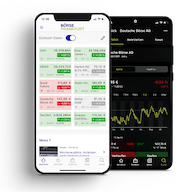Glossary
- Paasche index
- Par value
- Partial execution
- Participation certificates
- Pension fund
- Peoples share
- Performance evaluation
- Performance index
- Physical delivery (warrants)
- Placement
- Placement volume
- Pool factor
- Portfolio
- Practise
- Preferred shares
- Premium
- Premium (warrant)
- Premium Margin
- Price addendum
- Price category
- Price details
- Price index
- Price sensitivity
- Price-cashflow-ratio
- Price-earnings ratio
- Price-to-book-ratio
- Primary market
- Prime All Share
- Prime Standard
- Principle of highest volume transacted
- Private placement (PP)
- Proprietary trading
- Prospectus
- Put warrant
Price-earnings ratio
The P/E ratio is obtained by dividing the current share price by the net profit per share. The P/E ratio can be used to determine whether a share is undervalued or overvalued in relation to shares in the same industry and the market as a whole. The P/E ratio can only be determined if the company has generated profits. In the case of a loss, the P/E ratio is not used.
If, for example, the P/E ratio of a share is twelve (12 times annual earnings) and that of the sector is 14, it can be said to be undervalued. The greater the downward difference, the greater the undervaluation. Conversely, the greater the upward difference between the P/E ratio and the industry average, the greater the overvaluation.
Using the expected profit for the P/E ratio is the most meaningful. However, since this data is often not available, the reported profit of the previous fiscal year is usually used.
Current P/E ratios of companies listed on the Frankfurt Stock Exchange can be found on the data sheets of the shares on boerse-frankfurt.de .




